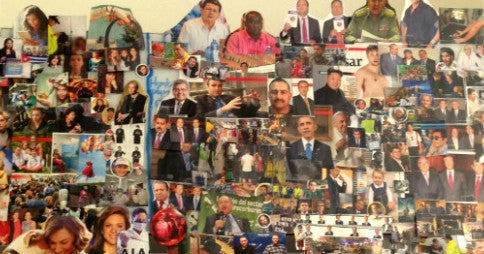Para leer en español, haz click aquí
Inspired by a video that revealed that images of women in a popular British newspaper were one-dimensional, I endeavored to see how a popular, prize-winning Colombian news magazine was portraying women. I bought two copies of the December 21, 2014 through January 4, 2015 edition and, lacking a handy team of cutting and pasting soldiers with 6 months to spare, I personally cut out all of the images of men and women I found in that one issue.
The basic rule I followed in the creation of my women’s images vs men’s images board was that, of course, all pictures of individual women, men and single sex groups would be used. I later added mixed gender pictures to the board if it was clear (to me) that one gender was the focus of the photo. Finally, to supplement (and continue with my awesome kindergarten throwback session) I created a separate mixed gender board with the pictures that did not make the cut.
What did I find with my little experiment?
 The number of images on each side of the board was starkly different. Women’s images are about one third those of men’s in this issue of the magazine.
The number of images on each side of the board was starkly different. Women’s images are about one third those of men’s in this issue of the magazine.
Although there were a few glamour shots, there was no nudity or near nudity among the women’s photos (that is actually reserved for the men’s side). The women in this issue engaged in an array of daily activities, from shopping, caring for and nursing children and working in healthcare to policing, scientific and construction work.
The more disappointing findings of the women’s images vs men’s images board are that:
- Women were less likely to be pictured alone. Women were alone in only 17% of the photos, while men were alone in almost 50% of the pictures.
- Women were more likely to be pictured in the company of children or pets (8% of women’s photos versus 3% of men’s photos).
- Men were almost never pictured engaging in traditionally female (0.01%) or home-related activities (0%).
- Although children did not factor in many of the stories, those who did appear were more likely to be male (63% of children’s photos).
- The photos of women give no indication that a woman might impart information. There was not a single photo of women speaking, while 8% of them included men speaking. This was true even in a photograph of a woman posed closed-mouthed at a podium (left side, upper left).
- While several male heads of state had many repeat photos, none of the women personalities were pictured more than once.
- Of the 4% of photos that included Afrocolombian or Afrodescendant people (even including U.S. President Barak Obama’s photos in this count), none of the photos include Afrocolombian or Afrodescendant women.
So what’s in an image?
We have learned in the past decades that media images can wreak havoc not only with girls’ and women’s body image, but also with their perceptions of their professional and academic abilities. Moreover, these images cement ideas of the ideal female form and ideal women’s roles into the minds and habits of boys and men. By underrepresenting women in serious media, publications limit girls and women to silent support roles, even when these women are in positions of power.
The magazine profiled and others like it have made significant advances in including images of women in both traditional and non-traditional activities and in not running advertisements that objectify women and men. Those two advances are to be applauded and encouraged. The next step is to turn the camera more often toward women while they are in action. There is no need to ask them to pose and smile, capture what they are doing because they are doing. Just as media has taken women’s voices, it can give them back, even if only on paper.
I invite you to make your own women’s images vs men’s images board in your country and to share it with us. What do you think you will find?


Leave a Reply